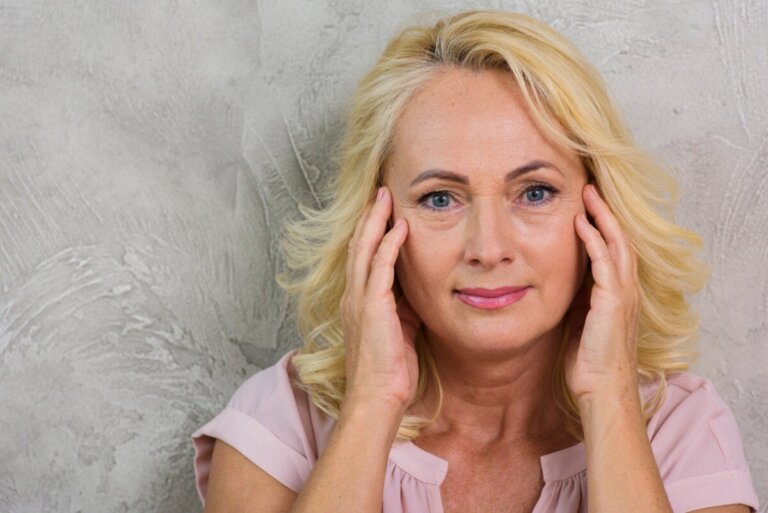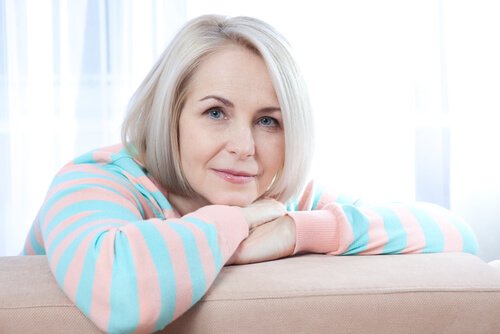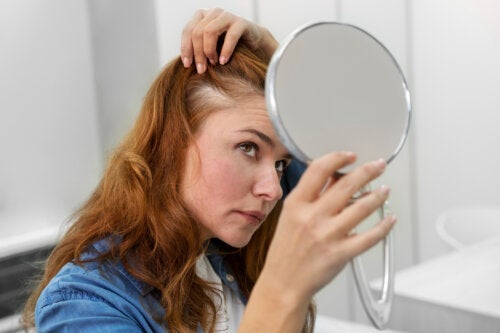9 Skin Changes During Menopause and How to Treat Them


Written and verified by the dermatologist Maria del Carmen Hernandez
Menopause is a natural stage in a woman’s life that marks the end of reproductive function. It’s characterized by significant hormonal changes and hormonal disruptions that can affect different areas of the body, including the skin. As hormones fluctuate, the skin undergoes a number of changes that can result in problems. Here are the most common skin changes during menopause and tips on how to treat them.
What happens to women’s skin during menopause?
The first signs of skin aging begin around age 30, when estrogen levels begin to decline. Some of the most frequent changes are thinning of the skin, the appearance of wrinkles, hyperpigmentation, and delayed wound healing.
But that’s not all. In the following article, we’ll explain all the changes that happen in the skin of menopausal women.

1. Dry skin
One of the most common changes during menopause is dry skin. Decreasing estrogen levels can reduce the production of mucopolysaccharides, hyaluronic acid, and natural oils in the skin, leading to the loss of hydration.
A study published in the journal Mechanisms of Ageing and Development states that “It’s important to point out that the skin is very affected by all these hormone changes, leading to a decrease in collagen content, water content, elasticity, thickness and impacting on all skin layers quality.”
There’s also a decrease in skin temperature in some areas of the body. Consequently, to combat dryness, it’s important to use moisturizers that are rich in ingredients such as hyaluronic acid and lipids.
A study of postmenopausal women published in the journal Menopauzalny suggests that argan oil in topical applications improves skin hydration and helps restore skin barrier function as well as maintain water retention capacity.
2. Wrinkles and fine lines
With aging and decreased collagen production, it’s common for wrinkles and fine lines to appear during menopause. An article published by the journal Dermato-Endocrinology describes the appearance of wrinkles around the mouth and eyes, and uneven skin color is seen in frown lines.
In these cases, the use of creams or serums containing retinoids and antioxidants can help reduce the appearance of these wrinkles and promote collagen production.
3. Sagging skin
Menopause can also cause sagging skin. Research published in the American Journal of Physical Anthropology explains that facial aging in women during menopause is associated with a flatter face, sagging and drooping soft tissues, folds around the nose, and deeper lips.
This is due to the loss of definition and abundance of elastin fibers that provide the necessary properties for skin elasticity. To counteract this problem, it’s important to incorporate muscle toning exercises and use firming creams containing active ingredients such as vitamin C, ferulic acid, collagen, and hyaluronic acid.
It’s important to incorporate foods that are rich in antioxidants in the diet, such as fruits and vegetables, to combat sagging skin.
A study published in the journal Evidence-Based Complementary and Alternative Medicine suggests that resveratrol offers anti-inflammatory, antioxidant, and anti-aging properties, as well as protection against UV radiation. As such, it may be an ideal component to include in your skincare routine.
4. Skin sensitivity
Skin sensitivity is one of the symptoms reported in menopausal women, which can lead to the appearance of redness, itching, and dryness.
It’s best to carry out a personal skincare routine that includes skin products without fragrances or alcohol, as well as avoid the use of hot water when washing the face.
5. Dark spots
Dark spots, also known as melasma or hyperpigmentation, are another common skin change during menopause. In fact, this hyperpigmentation can vary according to skin phototype and exposure to ultraviolet radiation.
The use of daily sunscreen with a high protection factor, as well as the application of depigmenting creams containing ingredients such as kojic acid and vitamin C, can help reduce the appearance of these spots.
6. Adult Acne
Although menopause is associated with a decrease in these acne breakouts, some women may experience adult acne during this stage due to hormonal changes. It’s important to use gentle facial cleansing products and seek the help of a dermatologist for proper treatment.
7. Varicose veins
During menopause, some women may experience the appearance of varicose veins in the legs. In addition, telangiectasias, which are small dilatations of blood vessels, especially capillaries, near the surface of the skin, increase.
A trial published in the European Journal of Vascular and Endovascular Surgery explains that menopause may be a risk factor in the development of vein diseases. To reduce the discomfort associated with these, it’s a good idea to wear compression stockings and elevate the legs when possible.
8. Dry scalp

The scalp can also be affected during menopause, becoming drier and prone to itching. In turn, reduced estrogen levels can decrease hair density, including body and pubic hair.
Using gentle shampoos and moisturizing conditioners can help keep the scalp healthy and reduce dryness. In addition, it’s best to avoid harsh hair treatments such as bleaching or perms.
9. Fragile nails
During menopause, some women may notice changes in the appearance and quality of their nails, such as brittleness and thinning. In addition, nail dystrophies, which are abnormal changes that affect nails in their texture, color, shape, and more, may appear.
Keeping nails short and using strengthening products can be useful to prevent breakage and improve their appearance.
Skin changes during menopause and the importance of medical consultation
Menopause can trigger a series of alterations in the skin due to hormonal fluctuations. However, there are several measures that can be taken to treat these changes and keep the skin healthy.
It’s important to practice a proper skincare routine, protect the skin from the sun, follow a balanced diet, and, if necessary, seek the advice of a dermatologist. With proper care, it’s possible to maintain healthy, radiant skin during menopause.
Menopause is a natural stage in a woman’s life that marks the end of reproductive function. It’s characterized by significant hormonal changes and hormonal disruptions that can affect different areas of the body, including the skin. As hormones fluctuate, the skin undergoes a number of changes that can result in problems. Here are the most common skin changes during menopause and tips on how to treat them.
What happens to women’s skin during menopause?
The first signs of skin aging begin around age 30, when estrogen levels begin to decline. Some of the most frequent changes are thinning of the skin, the appearance of wrinkles, hyperpigmentation, and delayed wound healing.
But that’s not all. In the following article, we’ll explain all the changes that happen in the skin of menopausal women.

1. Dry skin
One of the most common changes during menopause is dry skin. Decreasing estrogen levels can reduce the production of mucopolysaccharides, hyaluronic acid, and natural oils in the skin, leading to the loss of hydration.
A study published in the journal Mechanisms of Ageing and Development states that “It’s important to point out that the skin is very affected by all these hormone changes, leading to a decrease in collagen content, water content, elasticity, thickness and impacting on all skin layers quality.”
There’s also a decrease in skin temperature in some areas of the body. Consequently, to combat dryness, it’s important to use moisturizers that are rich in ingredients such as hyaluronic acid and lipids.
A study of postmenopausal women published in the journal Menopauzalny suggests that argan oil in topical applications improves skin hydration and helps restore skin barrier function as well as maintain water retention capacity.
2. Wrinkles and fine lines
With aging and decreased collagen production, it’s common for wrinkles and fine lines to appear during menopause. An article published by the journal Dermato-Endocrinology describes the appearance of wrinkles around the mouth and eyes, and uneven skin color is seen in frown lines.
In these cases, the use of creams or serums containing retinoids and antioxidants can help reduce the appearance of these wrinkles and promote collagen production.
3. Sagging skin
Menopause can also cause sagging skin. Research published in the American Journal of Physical Anthropology explains that facial aging in women during menopause is associated with a flatter face, sagging and drooping soft tissues, folds around the nose, and deeper lips.
This is due to the loss of definition and abundance of elastin fibers that provide the necessary properties for skin elasticity. To counteract this problem, it’s important to incorporate muscle toning exercises and use firming creams containing active ingredients such as vitamin C, ferulic acid, collagen, and hyaluronic acid.
It’s important to incorporate foods that are rich in antioxidants in the diet, such as fruits and vegetables, to combat sagging skin.
A study published in the journal Evidence-Based Complementary and Alternative Medicine suggests that resveratrol offers anti-inflammatory, antioxidant, and anti-aging properties, as well as protection against UV radiation. As such, it may be an ideal component to include in your skincare routine.
4. Skin sensitivity
Skin sensitivity is one of the symptoms reported in menopausal women, which can lead to the appearance of redness, itching, and dryness.
It’s best to carry out a personal skincare routine that includes skin products without fragrances or alcohol, as well as avoid the use of hot water when washing the face.
5. Dark spots
Dark spots, also known as melasma or hyperpigmentation, are another common skin change during menopause. In fact, this hyperpigmentation can vary according to skin phototype and exposure to ultraviolet radiation.
The use of daily sunscreen with a high protection factor, as well as the application of depigmenting creams containing ingredients such as kojic acid and vitamin C, can help reduce the appearance of these spots.
6. Adult Acne
Although menopause is associated with a decrease in these acne breakouts, some women may experience adult acne during this stage due to hormonal changes. It’s important to use gentle facial cleansing products and seek the help of a dermatologist for proper treatment.
7. Varicose veins
During menopause, some women may experience the appearance of varicose veins in the legs. In addition, telangiectasias, which are small dilatations of blood vessels, especially capillaries, near the surface of the skin, increase.
A trial published in the European Journal of Vascular and Endovascular Surgery explains that menopause may be a risk factor in the development of vein diseases. To reduce the discomfort associated with these, it’s a good idea to wear compression stockings and elevate the legs when possible.
8. Dry scalp

The scalp can also be affected during menopause, becoming drier and prone to itching. In turn, reduced estrogen levels can decrease hair density, including body and pubic hair.
Using gentle shampoos and moisturizing conditioners can help keep the scalp healthy and reduce dryness. In addition, it’s best to avoid harsh hair treatments such as bleaching or perms.
9. Fragile nails
During menopause, some women may notice changes in the appearance and quality of their nails, such as brittleness and thinning. In addition, nail dystrophies, which are abnormal changes that affect nails in their texture, color, shape, and more, may appear.
Keeping nails short and using strengthening products can be useful to prevent breakage and improve their appearance.
Skin changes during menopause and the importance of medical consultation
Menopause can trigger a series of alterations in the skin due to hormonal fluctuations. However, there are several measures that can be taken to treat these changes and keep the skin healthy.
It’s important to practice a proper skincare routine, protect the skin from the sun, follow a balanced diet, and, if necessary, seek the advice of a dermatologist. With proper care, it’s possible to maintain healthy, radiant skin during menopause.
All cited sources were thoroughly reviewed by our team to ensure their quality, reliability, currency, and validity. The bibliography of this article was considered reliable and of academic or scientific accuracy.
- Boucetta, K. Q., Charrouf, Z., Derouiche, A., Rahali, Y., & Bensouda, Y. (2014). Skin hydration in postmenopausal women: Argan oil benefit with oral and/or topical use. Menopauzalny, 13(5), 280-288. https://www.termedia.pl/Skin-hydration-in-postmenopausal-women-argan-oil-benefit-with-oral-r-nand-or-topical-use,4,23837,0,1.html
- Khunger, N., & Mehrotra, K. (2019). Acné menopáusico: desafíos y soluciones. International Journal of Women’s Health, 11, 555-567. https://doi.org/10.2147/IJWH.S174292
- Lephart, E. D. (2018). A review of the role of estrogen in dermal aging and facial attractiveness in women. Journal of cosmetic dermatology, 17(3), 282-288. https://pubmed.ncbi.nlm.nih.gov/29436770/
- Mirmirani P. (2013). Managing hair loss in midlife women. Maturitas, 74(2), 119–122. https://www.sciencedirect.com/science/article/abs/pii/S0378512212003684
- Reus, T., Brohem, C., Schuck, D., & Lorencini, M. (2020). Revisiting the effects of menopause on the skin: functional changes, clinical studies, in vitro models and therapeutic alternatives. Mechanisms of ageing and development, 185, 111193. https://www.sciencedirect.com/science/article/abs/pii/S0047637419301988
- Thornton, M. J. (2013). Estrogens and aging skin. Dermato-endocrinology, 5(2), 264-270. https://www.tandfonline.com/doi/full/10.4161/derm.23872
- Wen, S., Zhang, J., Yang, B., Elias, P. M., & Man, M. Q. (2020). Role of resveratrol in regulating cutaneous functions. Evidence-Based Complementary and Alternative Medicine, 14. https://www.hindawi.com/journals/ecam/2020/2416837/
- Windhager, S., Mitteroecker, P., Rupić, I., Lauc, T., Polašek, O., & Schaefer, K. (2019). Facial aging trajectories: A common shape pattern in male and female faces is disrupted after menopause. American journal of physical anthropology, 169(4), 678-688. https://pubmed.ncbi.nlm.nih.gov/31189026/
- Zolotukhin, I. A., Seliverstov, E. I., Shevtsov, Y. N., Avakiants, I. P., Nikishkov, A. S., Tatarintsev, A. M., & Kirienko, A. I. (2017). Prevalence and risk factors for chronic venous disease in the general Russian population. European Journal of Vascular and Endovascular Surgery, 54(6), 752-758. https://www.sciencedirect.com/science/article/pii/S1078588417305373
- Zouboulis, C. C., Blume-Peytavi, U., Kosmadaki, M., Roó, E., Vexiau-Robert, D., Kerob, D., & Goldstein, S. R. (2022). Skin, hair and beyond: the impact of menopause. Climacteric, 25(5), 434-442. https://www.tandfonline.com/doi/full/10.1080/13697137.2022.2050206
This text is provided for informational purposes only and does not replace consultation with a professional. If in doubt, consult your specialist.








